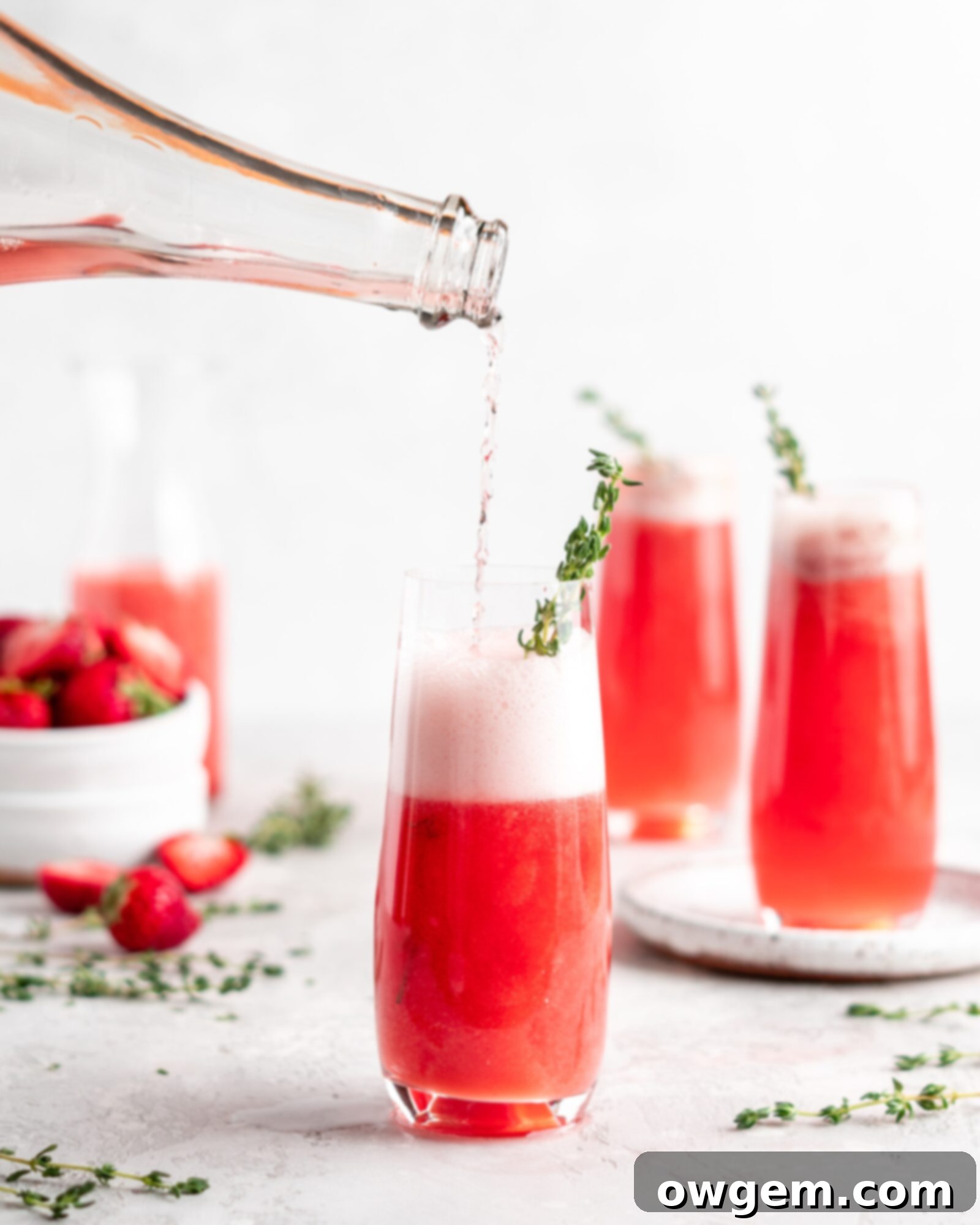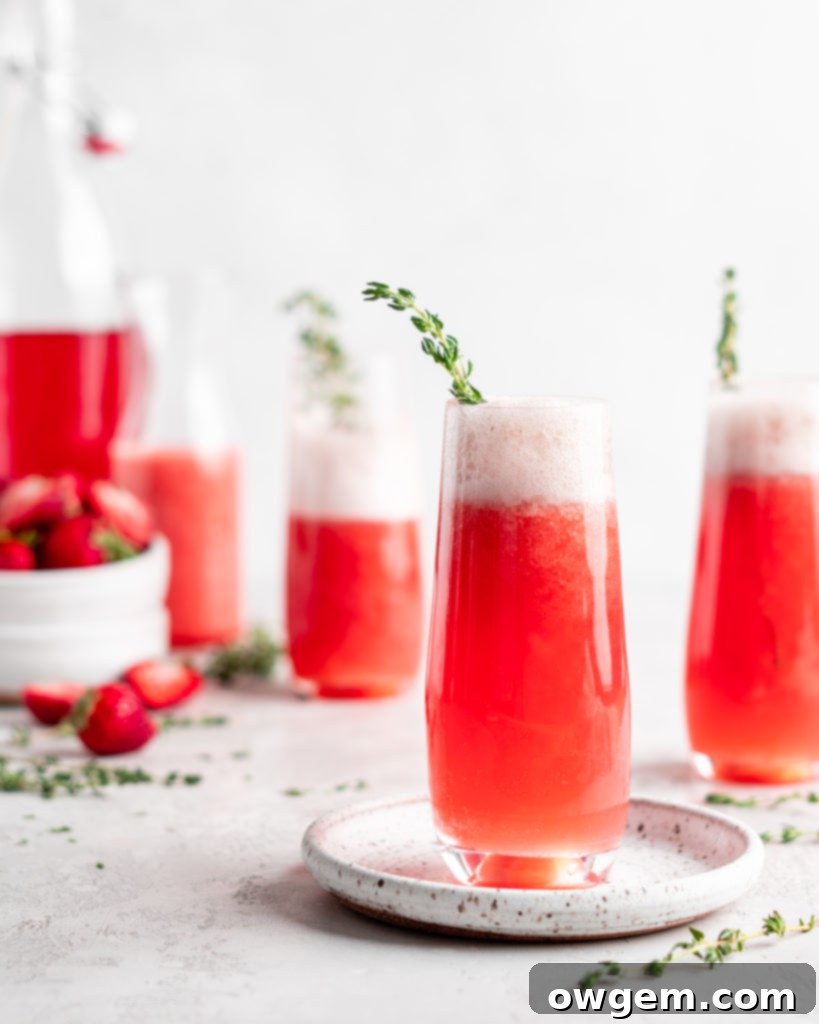Strawberry Guava Mimosas: The Ultimate Fruity & Bubbly Brunch Cocktail
Get ready to elevate your brunch experience with these absolutely gorgeous Strawberry Guava Mimosas! This vibrant, refreshing drink is the perfect summer-brunch companion, but honestly, it’s fantastic any time of year you crave a taste of sunshine. Featuring a luscious blend of sweet, exotic guava nectar and juicy, ripe strawberries, this concoction is then gracefully married with an extra-dry sparkling rosé wine. The result is a stunning mimosa that bursts with tropical fruit flavors, offers a delightful sweetness, and, of course, boasts that signature beautiful bubbly effervescence we all adore. It’s not just a drink; it’s a celebration in a glass, ideal for gathering with friends, holiday breakfasts, or simply enjoying a luxurious weekend morning.
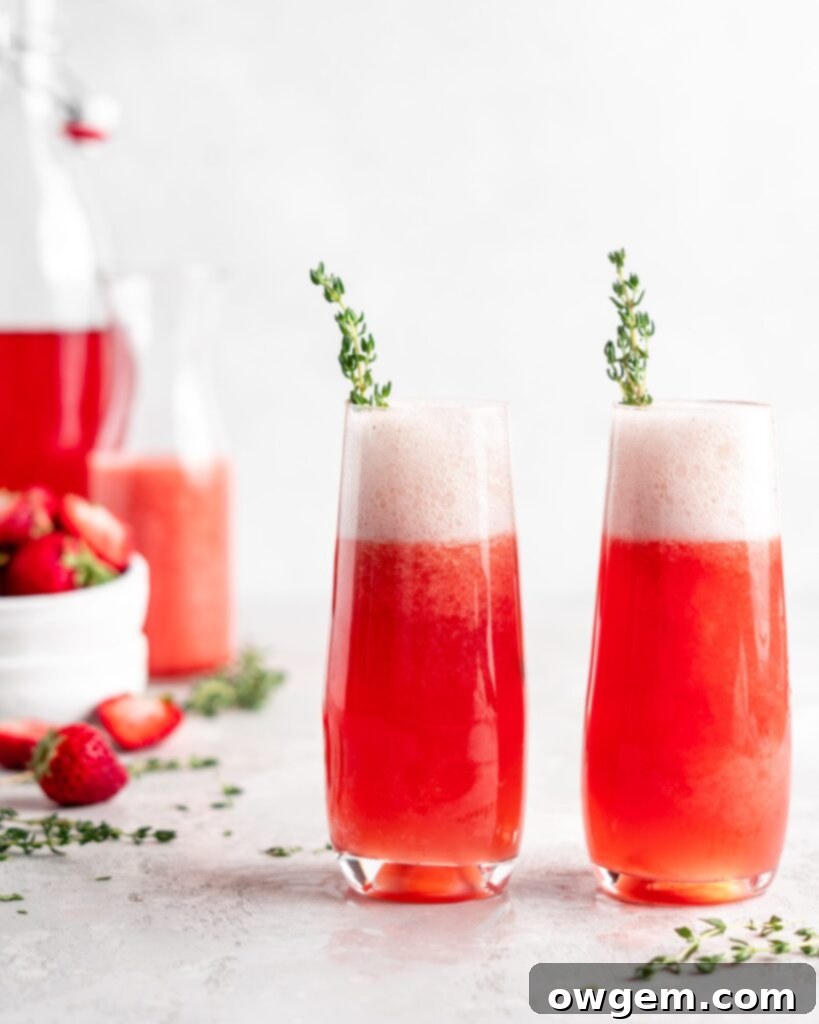
Why These Strawberry Guava Mimosas Are a Must-Try
If you’re looking to add a touch of elegance and irresistible flavor to your next gathering, these Strawberry Guava Mimosas are your answer. Forget the basic orange juice mimosa; this recipe introduces a tropical twist that will surprise and delight your guests. The vibrant red hue alone is enough to capture attention, hinting at the burst of flavor to come. Guava brings a unique, subtly floral sweetness that perfectly complements the familiar tartness of fresh strawberries. When combined with the crispness of sparkling rosé, it creates a balanced and incredibly refreshing cocktail that’s not too sweet, not too dry, but just right. It’s surprisingly simple to make, yet it presents as a sophisticated, gourmet drink, making you the ultimate host without breaking a sweat. It’s truly an experience for your taste buds, promising a perfect blend of sweetness, acidity, and effervescence.
Navigating the Sweetness Levels of Sparkling Wines
It’s a common point of confusion for many bubbly enthusiasts, but understanding the sweetness levels of sparkling wines is key to crafting the perfect mimosa. Sparkling wine and champagne are typically categorized into five main sweetness levels, each determined by the amount of residual sugar (dosage) added during production. You might instinctively think “extra-dry” would be the driest, but in the nuanced world of wine, it’s actually quite the opposite! Let’s demystify these terms to help you choose the ideal bottle for your Strawberry Guava Mimosas:
- Extra Brut: This is the driest and least sweet option, often containing almost no added sugar (0-6 grams of sugar per liter). It offers a very crisp, pure taste, often with high acidity, making it ideal for pairing with oysters or delicate appetizers.
- Brut: The most popular and versatile category, Brut wines are dry with a hint of fruitiness (up to 12 grams of sugar per liter). They are excellent for a wide range of palates and food pairings, from savory dishes to light desserts. Many popular champagnes fall into this category.
- Extra Dry (or Extra Sec): This is where the confusion often lies! Despite its name, Extra Dry sparkling wine is actually slightly sweeter than Brut, typically containing 12-17 grams of sugar per liter. It’s known for its crisp, light sweetness and softer acidity, which makes it incredibly approachable and pleasant on its own or with lighter fare.
- Dry (or Sec): Sweeter still, Dry sparkling wines have a noticeable sweetness (17-32 grams of sugar per liter). They can be a lovely choice for dessert or those who prefer a less acidic bubbly, pairing well with fruit tarts or mild cheeses.
- Demi-Sec: The sweetest category, Demi-Sec wines can have up to 32-50 grams of added sugar per liter. These are truly sweet and best enjoyed as a dessert wine, complementing rich chocolate or cream-based desserts beautifully.
For these vibrant Strawberry Guava Mimosas, I wholeheartedly recommend using an Extra-Dry Sparkling Rosé Wine. Its subtle sweetness and bright acidity perfectly complement the tropical fruit puree without making the drink overly saccharine. The “extra-dry” characteristic ensures the mimosa remains light and refreshing, allowing the natural flavors of the strawberry and guava to shine through beautifully. Using a Brut might make the mimosa a touch too tart, potentially overpowering the fruit, while a Demi-Sec would likely result in an excessively sweet drink that completely masks the delicate fruit notes. The rosé variety also lends a beautiful pink hue that enhances the visual appeal, aligning perfectly with the strawberry and guava colors.
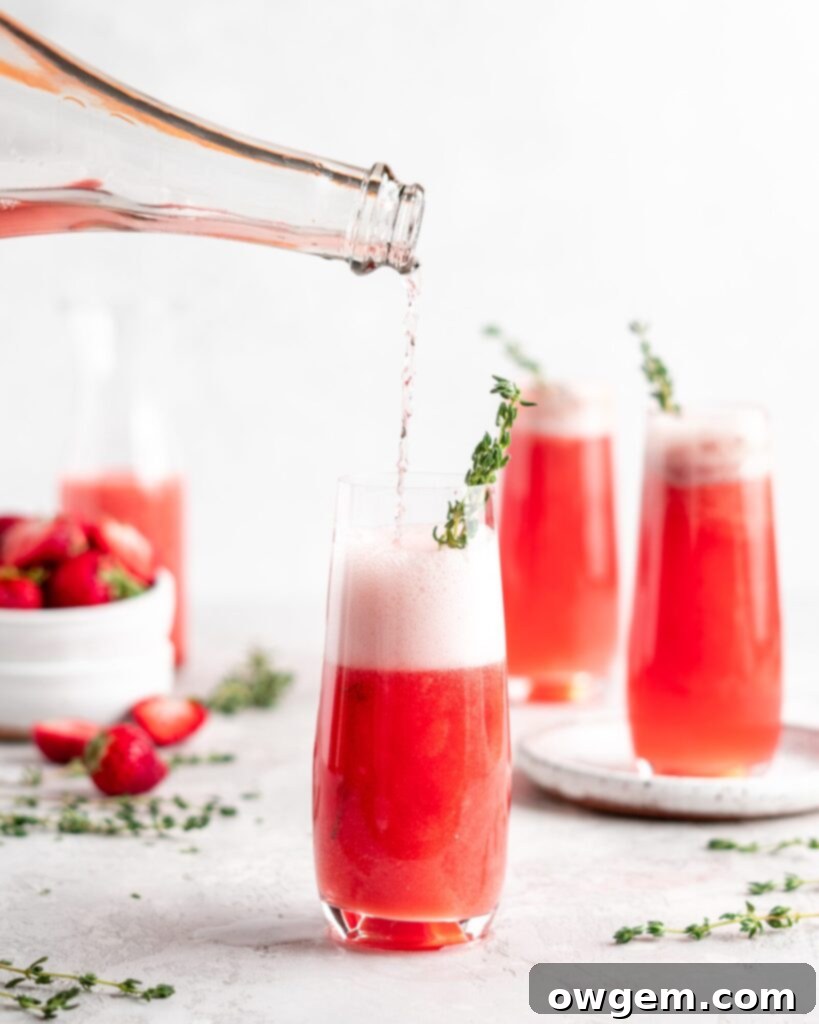
Essential Ingredients for Your Strawberry Guava Mimosa
Crafting the perfect Strawberry Guava Mimosa starts with selecting high-quality ingredients. Each component plays a crucial role in achieving that delightful balance of sweet, tart, and bubbly, contributing to the overall success and flavor profile of your cocktail:
Fresh Strawberries: For the most vibrant flavor and captivating color, always opt for ripe, sweet fresh strawberries. Look for berries that are bright red, firm, and free from bruises. The fresh strawberries in this recipe are pureed alongside the guava nectar. This blended mixture is then carefully strained through a fine-mesh sieve. This step is absolutely critical for removing any unwanted seeds and fibrous pulp, ensuring a silky-smooth, elegant juice that won’t interfere with the delicate bubbles of the sparkling wine. If fresh strawberries aren’t in season or readily available, high-quality frozen strawberries (thawed beforehand) can be a suitable alternative, though fresh will always yield the most intense and authentic flavor profile.
Guava Nectar or Juice: Guava nectar is a rich, intensely sweet, and beautifully fragrant juice made from guavas. It often has a slightly thicker consistency than pure juice and may contain some fruit pulp, contributing to the body and texture of the mimosa. You can typically find guava nectar or juice in the international foods aisle of larger supermarkets or specialty grocery stores. Brands like Kern’s or Goya are often good choices. Ensure it’s well-chilled before mixing, as cold liquids retain carbonation better. While guava juice works, guava nectar tends to provide a more pronounced and luxurious guava flavor due to its concentrated nature and slightly sweeter profile, which perfectly complements the strawberries.
Extra-Dry Sparkling Rosé Wine: Moving away from traditional champagne, this Strawberry Guava Mimosa recipe specifically calls for Sparkling Rosé Wine. There are several compelling reasons for this choice. Firstly, sparkling rosé often offers a delightful fruity undertone with notes of red berries (like raspberry or cherry) that perfectly harmonizes with the strawberry and guava flavors, enhancing the overall complexity of the drink. Secondly, it tends to be more budget-friendly than traditional champagne, making it an excellent and equally celebratory choice for entertaining. As discussed earlier, an “Extra-Dry” variety is preferred to ensure a crisp finish that isn’t overly sweet when combined with the naturally sweet fruit juice. Look for a good quality Prosecco Rosé or Cava Rosé if you want to explore excellent, cost-effective options beyond French sparkling wine; they often deliver fantastic fruit-forward characteristics.
Mastering the Mimosa Ratio for Your Perfect Sip
The beauty of a mimosa lies in its simplicity and adaptability, and the ratio of sparkling wine to juice is a perfect example of this flexibility. The optimal and traditional ratio for mimosas is typically a 50/50 split – meaning half sparkling wine and half juice. This classic balance ensures you get the refreshing bubbles and alcohol content from the wine, harmoniously blended with the sweet and fruity notes of your juice, creating a well-rounded and universally appealing drink.
However, this is merely a starting point, and your personal preference should always guide you. If you lean towards a less sweet, more boozy version of this Strawberry Guava Mimosa, feel empowered to adjust the ratio by using slightly less juice and a bit more sparkling wine. This will highlight the wine’s characteristics and provide a drier, more spirited finish, ideal for those who appreciate the nuances of the bubbly itself. Conversely, if you desire a sweeter, less alcoholic mimosa – perhaps for a lighter daytime sip, or if your guests have a particularly sweet tooth – simply increase the proportion of the strawberry guava mixture. Don’t be afraid to experiment! Start with the 50/50 and then incrementally adjust until you find your perfect balance. A good tip is to have both components ready and let your guests customize their own glasses, offering a personalized touch to your brunch spread and catering to individual tastes.

Expert Tips for Crafting the Perfect Strawberry Guava Mimosa
While seemingly straightforward, a few key techniques can elevate your mimosa from good to absolutely perfect. Follow these expert tips for a consistently delicious and beautifully bubbly drink every time, ensuring maximum enjoyment for you and your guests:
- Well-Chilled Juice and Sparkling Wine: This tip might seem like a no-brainer, but its importance cannot be overstated! Both your sparkling wine and your strawberry-guava juice should be thoroughly chilled, ideally straight from the refrigerator, for several hours prior to serving. Warm liquids lose their carbonation much faster, resulting in a flat, less enjoyable mimosa. Chilled ingredients ensure maximum effervescence and a wonderfully refreshing sip. For an extra touch of cool elegance, you can even chill your champagne flutes in the freezer for 10-15 minutes before serving.
- Choose the Right Glassware: While any glass can hold a drink, champagne flutes are specifically designed to enhance the mimosa experience. Their tall, slender shape minimizes the surface area exposed to the air, which significantly helps to retain the sparkling wine’s precious carbonation for longer. This means your mimosa will stay delightfully bubbly throughout your enjoyment, as opposed to quickly going flat in a wider glass like a coupe. The elegant presentation also adds to the festive atmosphere.
- Pour Sparkling Wine at an Angle: Ever noticed how professional bartenders pour beer or sparkling wine? The same principle applies to mimosas! By tilting your champagne flute to a 45-degree angle and slowly pouring the sparkling wine down the side of the glass, you significantly reduce the amount of foam build-up. This gentle pouring technique helps to preserve the wine’s carbonation, ensuring your mimosa remains vibrant and effervescent for as long as possible. Pouring directly into the bottom causes more agitation and thus more bubble loss.
- Avoid Stirring: Once your sparkling wine and juice are combined, resist the urge to stir vigorously! Agitating the mixture will cause the carbonation to dissipate rapidly, leading to a flat drink. If you feel the need to gently combine the ingredients, a very slight swirl of the glass (without lifting it from the table) is all that’s typically needed. The natural rise of the bubbles will do most of the mixing for you, gently blending the flavors.
- Garnish for Elegance: A beautiful mimosa deserves a beautiful garnish! A fresh strawberry slice perched on the rim of the glass, a small wedge of guava, or even a delicate sprig of fresh mint or basil can add a touch of sophistication and enhance the visual appeal of your cocktail, making it even more inviting and photo-worthy.
- Prepare Juice Ahead: The strawberry-guava juice mixture can be prepared up to 24-48 hours in advance and stored in an airtight container in the refrigerator. This allows the flavors to meld beautifully and significantly cuts down on prep time just before serving, making entertaining a breeze. Just give it a quick stir before pouring into glasses.
Serving Suggestions & Delightful Variations
These Strawberry Guava Mimosas are incredibly versatile and can be adapted to suit various tastes and occasions. For a crowd, consider setting up a mimosa bar! Have your chilled strawberry-guava puree in a beautiful carafe or dispenser, alongside bottles of sparkling rosé in an ice bucket, and a selection of garnishes like fresh berries, citrus slices, or even edible flowers. This allows guests to craft their own perfect drink, making for an interactive and enjoyable experience.
Feeling adventurous? Here are a few delightful variations to spark your creativity:
- Non-Alcoholic Version (Mockmosa): For a delightful mocktail that everyone can enjoy, simply substitute the sparkling rosé with sparkling water, lemon-lime soda, ginger ale, or a non-alcoholic sparkling cider. It retains all the fruity goodness and effervescence without the alcohol, perfect for all ages or designated drivers.
- Herbaceous Twist: Muddle a few fresh basil or mint leaves into your strawberry-guava puree before straining for an added layer of refreshing herbaceousness and complexity. This subtle aromatic touch can truly elevate the drink.
- Tropical Medley: For an even more intense tropical experience, experiment with adding a splash of pineapple juice, mango puree, or passion fruit puree to your strawberry-guava blend. Just be mindful of the added sweetness and adjust your sparkling wine choice accordingly.
- Frozen Mimosa: For a hot summer day, blend the strawberry guava puree with a handful of ice and a splash of sparkling rosé (or non-alcoholic alternative) to create a slushy-style frozen mimosa. Serve in a chilled glass for a super refreshing treat.
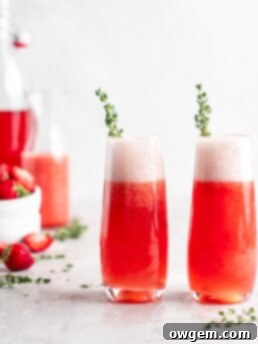
Get the Recipe:
Strawberry Guava Mimosas
Pin
Rate
Ingredients
- 1 ½ cups Fresh Strawberries,, halved with leaves removed, for best flavor and color
- 1 ½ cups Guava Nectar or Juice,, premium quality, well chilled for optimal refreshment
- 750 mL (25.4 oz) Bottle of Extra-Dry Sparkling Rosé Wine,, thoroughly chilled to maintain effervescence
Equipment
-
Blender (for pureeing the fruit)
-
Fine-mesh sieve (for a smooth, seedless juice)
-
Champagne flutes (to preserve bubbles)
Instructions
-
Begin by preparing your fruit puree. Add the fresh strawberries and well-chilled guava nectar (or juice) to a blender. Blend until the strawberries are completely broken down and the mixture is smooth. For an impeccably smooth mimosa free of any bits, pour this blended mixture through a fine-mesh sieve into a clean bowl or pitcher. Press down on any solids with a spoon to extract as much juice as possible, discarding the remaining pulp and seeds. Ensure this juice is thoroughly chilled if not already. This step can be done up to 24-48 hours in advance.
-
To assemble your mimosas, take your chilled champagne flutes. Gently pour the thoroughly chilled extra-dry sparkling rosé wine into each flute, filling it approximately 50% full (or to your preferred ratio, adjusting for sweetness and alcohol content). Allow the initial effervescence to settle slightly. Then, carefully top off the remaining 50% of the glass with your prepared strawberry guava mixture. Serve immediately to enjoy the delightful effervescence and fruity flavors! For an extra touch, garnish with a fresh strawberry slice or a small guava wedge on the rim. Remember to avoid stirring to preserve the bubbles.
Frequently Asked Questions (FAQs) About Strawberry Guava Mimosas
- Can I make the strawberry guava juice ahead of time?
- Absolutely! Preparing the strawberry guava puree in advance is highly recommended, especially when entertaining. You can blend and strain the mixture up to 24-48 hours before your event. Store it in an airtight container or pitcher in the refrigerator to keep it fresh and perfectly chilled. This significantly streamlines your serving process on the day of, allowing you more time to enjoy with your guests without last-minute fuss. Just give it a quick stir before pouring.
- What if I can’t find guava nectar? What are good substitutes?
- While guava nectar is preferred for its richer flavor and consistency, guava juice can certainly be used as a substitute. If using guava juice, you might find the mimosa slightly less sweet, so you can adjust the mimosa ratio by adding a touch more juice if desired. Alternatively, you could enhance the sweetness with a tiny dash of simple syrup or agave nectar, but always taste first! If guava is entirely unavailable, a blend of mango and passion fruit juice could offer a similar tropical vibe, though the flavor profile will differ.
- What’s the best way to keep mimosas cold for a party?
- To keep your mimosas perfectly chilled, especially if serving a crowd, consider using an ice bucket filled with ice for your bottles of sparkling rosé. For the juice, you can serve it from a chilled carafe or pitcher that is frequently refilled from a larger batch kept in the refrigerator. Pre-chilling your glasses is also a fantastic idea. Avoid adding ice directly to the mimosas in individual glasses, as it will dilute the delicious flavors and quickly flatten the delicate bubbles, ruining the texture.
- Can I use a different type of sparkling wine if I don’t have rosé?
- While extra-dry sparkling rosé is specifically recommended for its ideal balance and beautiful color with the fruit, you can certainly experiment with other options. A Brut Prosecco or Cava (white) would also work beautifully, offering a drier profile and allowing the fruit flavors to stand out. If you prefer a sweeter mimosa, a regular Extra Dry (white) sparkling wine or even a Prosecco would be an option, but be mindful of the added sugar interacting with the already sweet fruit puree. Always choose a wine you enjoy drinking on its own, as its flavor will be a prominent part of your mimosa!
- How many mimosas does one bottle of sparkling wine make?
- A standard 750ml bottle of sparkling wine typically yields about 6-8 servings when making mimosas, assuming a 50/50 ratio in standard champagne flutes. Since this recipe uses 1.5 cups (about 350ml) of juice, a 750ml bottle of wine would make roughly 4-6 mimosas depending on your pour size and ratio preference. If you’re hosting a larger gathering, plan to have multiple bottles on hand!
